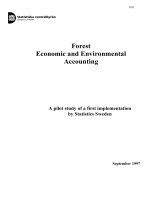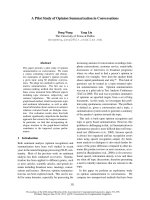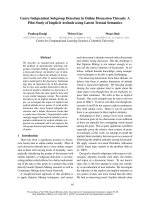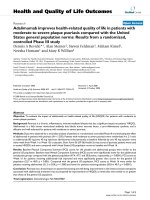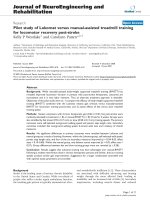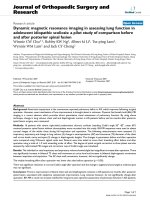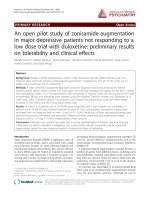Randomized, controlled clinical pilot study of venous leg ulcers treated with using two types of shockwave therapy
Bạn đang xem bản rút gọn của tài liệu. Xem và tải ngay bản đầy đủ của tài liệu tại đây (1.01 MB, 11 trang )
Int. J. Med. Sci. 2018, Vol. 15
Ivyspring
International Publisher
1275
International Journal of Medical Sciences
2018; 15(12): 1275-1285. doi: 10.7150/ijms.26614
Research Paper
Randomized, controlled clinical pilot study of venous leg
ulcers treated with using two types of shockwave
therapy
Patrycja Dolibog1, Paweł Dolibog1, Andrzej Franek1, Ligia Brzezińska-Wcisło2, Hubert Arasiewicz2, Beata
Wróbel1, Daria Chmielewska3, Jacek Ziaja4, Edward Błaszczak1
1.
2.
3.
4.
Chair and Department of Medical Biophysics, School of Medicine in Katowice, Medical University of Silesia
Department of Dermatology, School of Medicine in Katowice, Medical University of Silesia
Department of Basics of Physiotherapy, Faculty of Physiotherapy, Academy of Physical Education in Katowice
Department of General, Vascular and Transplant Surgery, School of Medicine in Katowice, Medical University of Silesia
Corresponding author: Patrycja Dolibog,
© Ivyspring International Publisher. This is an open access article distributed under the terms of the Creative Commons Attribution (CC BY-NC) license
( See for full terms and conditions.
Received: 2018.04.11; Accepted: 2018.06.30; Published: 2018.08.06
Abstract
Background. Venous leg ulcers are difficult to heal wounds. The basis of their physiotherapeutic
treatment is compression therapy. However, for many years, the search for additional or other
methods to supplement the treatment of venous ulcers, which would shorten the duration of
treatment, is underway. One of such methods is the shockwave therapy.
Methods. The purpose of our study was to compare radial shockwave therapy (R-ESWT) with
focused shockwave therapy (F-ESWT) in venous leg ulcers treatment.
Patients were randomly assigned to tree groups. In the first group the radial shockwave therapy
(0.17mJ/mm2, 100 impulses/cm2, 5 Hz), in the second group the focused shockwave therapy
(0.173mJ/mm2, 100 impulses/cm2, 5 Hz) was used and in third group standard care was used.
Patients in shockwave therapy groups were given 6 treatments at five-day intervals. Total area,
circumference, Gilman index, maximum length and maximum width of ulcers were measured. The
patients from the third group wet gauze dressing with saline and gently compressing elastic bandages
were used (standard wound care SWC).
Results. Analysis of the results shows that a complete cure of ulcers was achieved in 35% of
patients who were treated with radial shockwave, 26% of patients with focused shockwave used.
There is statistically significant difference between the standard care and radial shockwave therapy
as well as between the standard care and focused shockwave therapy. There is no statistically
significant difference between the use of radial and focused shockwave in the treatment of venous
leg ulcers (p> 0.05).
Conclusion. There is no statistically significant difference between the use of radial and focused
shockwave in the treatment of venous leg ulcers. Treatment of venous leg ulcers with shockwaves
is more effective than the standard wound care.
Key words: radial shockwave therapy, focused shockwave therapy, venous leg ulcers, wound healing
Introduction
Chronic venous insufficiency is the most
common form of venous disease that occurs in 1% of
the population predominantly among women than
men, in a 2: 1 ratio. The frequency of its occurrence
increases with age [1-4].
Venous leg ulcers are the most common result of
a chronic venous insufficiency. It is estimated that
venous leg ulcers in Western Europe are present in
0.3% - 1% of the adult population and it number
increases to 3-4% in the range of 65-80 years [3,5,6].
Int. J. Med. Sci. 2018, Vol. 15
Leg ulcers are the serious medical and socioeconomic problem because of the chronicity. These
wounds contribute to lowering the quality of life due
to physical condition (sleep quality, ability to work,
mobility), psychological (appearance, concentration),
social (interpersonal) and environmental (housing,
financial resources, medical care) [7].
Compression therapy, leg elevation and wet
dressings are the standard care for venous ulcers and
chronic venous insufficiency. Pharmacological
treatment is taking edema-protective agents
(phlebotropic drugs), pentoxifylline or aspirin;
surgical management include debridement, skin
grafting, human skin equivalent and surgery for
venous insufficiency. In addition, to support healing,
applied physical methods such as high voltage
electrostimulation, direct current electrostimulation,
low-level laser therapy, ultrasound therapy, low
frequency magnetic therapy, hyperbaric oxygen
therapy [8,9,10].
In recent years, shockwave is used for soft tissue
defects treatment. It is a mechanical wave on the front
of which the pressure increases from the value of
which the environment has to the maximum value
(100 MPa) in time of nanoseconds (<10ns). The
pressure then decreases exponentially to achieving
the smaller value than the initial value (air) and it
increases to the initial value. The whole cycle takes
about 10 ms. The frequency of the generated wave is
in the range of 16 Hz to 20 MHz. The propagation
speed of the shockwave is greater than the
propagation velocity of the acoustic wave in the
material [11-14].
The therapeutic effects of the shockwave
depends largely on the amount of energy released
during the treatment, and therefore one of the most
important parameter is the energy concentrated in the
unit area (mJ/mm2), referred to as surface energy
density. Due to the energy the shockwave can be
divided into a low-energy <0.2 mJ/mm2 (LESWT low energy shockwave therapy), and the high energy
of> 0.2 mJ/mm2 (HESWT - high energy shockwave
therapy) [15-19].
The shockwave is usually generated in a device
outside a patient's body, which is in english naming
ESWT (Extracorporeal Shockwave Therapy), or
shorter SWT (Shockwave Therapy). Then the wave is
delivered to the destination by using a corresponding
transducer focusing the wave by using overlays
(acoustic
lens)
focusing
F-ESWT
(Focused
Extracorporeal Shockwave Therapy) or distracting
D-ESWT (defocused, Unfocused - Extracorporeal
Shockwave Therapy). Other transducer can deliver
radial wave ESWT (R-ESWT) or flat (planar) wave
ESWT (P-ESWT) [11-19].
1276
Scientific publications describe the use of
focused and unfocused shockwave treatment results
in accelerated healing and regeneration of diverse
ethology wounds which are the effect of increased
secretion of vascular endothelial growth factor to
induce neovascularization and improve blood flow to
tissues. Additionally, increase in metabolic rate and
initiation of cell proliferation and differentiation has
been documented [by 20].
Aschermann et al. [21] used a shockwave
ESWT 100 impulses per cm2, energy flux density of
0.136 mJ/mm2 and a frequency of 4 Hz (4 times once
every 3-4 weeks) to treat 60 patients with chronic leg
ulcers. The authors report that they noted
morphological changes and increased cell migration
of keratinocytes, moreover cell-cycle regulators genes
were upregulated, and proliferation induced in
fibroblasts. In addition, they have observed secretion
of pro-inflammatory cytokines from keratinocytes,
which drive to pro-angiogenic activity of endothelial
cells and wound healing.
The aim of our study was to compare two types
of shockwaves therapy in venous leg ulcers (R-ESWT
vs. F-ESWT) and standard care therapy. Primary
study endpoints were analysis of changes of the total
ulcer surface area and linear dimensions inside
groups. The secondary endpoints were comparisons
between all groups the number of completely healed
wounds, Gilman index and percentage change of
ulcer surface area and nonlinear approximation of
treatment results.
Material and Methods
The studies lasted from February 2016 to
December 2017. All the patients (n = 65) were treated
in Department of Dermatology of the Medical
University of Silesia, Katowice, Poland. Patients were
diagnosed
dermatologically
and
surgically.
Dermatological examination included evaluation
symptoms of chronic venous insufficiency (CVI) like
swelling, skin discoloration and lipodermatosclerosis.
Setting and sample. All patients referred to the
study underwent ultrasound examination of arteries
and veins of lower limbs performed using Aloka
Prosound Alpha 6 ultrasound device (Hitachi Aloka
Medical, Ltd., Japan). Patients with occlusion or
hemodynamically significant stenosis of limb arteries
revealed in Doppler examination, as well as
post-thrombotic occlusion of iliac, femoral, or
popliteal veins were excluded from the study.
In all patients enrolled into the study blood flow
in iliac, proximal and distal segments of femoral,
popliteal, upper and lower segments of great
saphenous, and small saphenous veins (including
Int. J. Med. Sci. 2018, Vol. 15
saphenofemoral and saphenopopliteal junctions) was
examined.
Also the ankle brachial pressure index (ABPI)
was established, which for all patients was higher
than 1.
Exclusion criteria for the patients were: diabetes,
atherosclerosis,
rheumatoid
arthritis,
cancers,
peripheral nerve damage, ventricular arrhythmia,
cardiac pacemakers, and surgical treatment of ulcers,
infections of the skin, pregnant, and those who
reported the presence of implants from foreign bodies
in the potential field of application. There were no
restrictions on race, age, ulcer duration or gender.
Ethical consideration. All patients signed
written agreement forms. The local Bioethics
Committee of the Medical University of Silesia in
protocol no KNW/0022/KB1/25/II/15 has agreed to
carry out this medical experiment. All clinical
investigation was conducted according to the
principles expressed in the Declaration of Helsinki.
Randomization and Intervention. Patients who
consented to participate in the study and gave signed
informed consent were randomly allocated to three
groups at using website random.org to true random
number generator was generated group number, then
each number was assigned to patient. A technician
from Department of Medical Biophysics collected and
coded data into an Excel database and export to
Statistica database. Technician had no contact with
any patients and could not identify them.
Patients selected for the treatment (n = 57) were
assigned randomly into three groups A, B, and C.
Seven patients incomplete treatment (Figure 1).
Group A consisted of 17 patients, including 12
women and 5 men. The average age of the patients
was 71.7 ± 8.1 years; the duration of the ulcers ranged
from 2 to 24 months (Table 1). In this group the radial
shockwave R-ESWT was used (producer: Gymna
Uniphy; model: ShockMaster 500; applicator: classic
15mm) with a surface energy density 0.17mJ/mm2,
100 impulses/cm2, frequency of 5 Hz and a pressure
of 0.2 MPa. Directly on the wound sterile ultrasound
gel was applied (Aquasonic 100) then a sterile
operation foil was glued (elastoFILM Company
Outline, Poland) and a gel was applied second time.
The applicator's surface was disinfected after each
treatment. The treatments were carried out without
anesthesia. Six treatments were made at intervals of 5
days. The first three treatments were performed
during the stay of patients in the hospital, and for the
next three treatments, patients reported individually
at the appointed time (outpatient treatment). Between
treatments wet gauze dressing with saline and gently
compressing elastic bandages were used. Moist
dressings prevent the formation of scabs and the
1277
drying of the ulcer surface, it has a high absorption,
does not adhere to the wound surface, allows painless
change, protects the wound from external pollution,
are non-toxic and non-allergic. In addition, they
maintain a normal wound temperature close to the
body temperature.
Group B consisted of 15 patients, including 7
women and 8 men. The average age of the patients
was 69.1 ± 8.9 years; the duration of the ulcers ranged
from 3 to 24 months (Table 1). In this group the
focused shockwave F-ESWT was used (producer:
Wolf, model: Piezowave; head: F10G4) with a surface
energy density 0.173mJ/mm2, 100 impulses/cm2,
frequency of 5 Hz and a peak pressure of 35.6 MPa.
Identical to patients from group A, for patients in
group B directly on the wound sterile ultrasound gel
was applied (Aquasonic 100) then a sterile operation
foil was glued (elastoFILM Company Outline,
Poland) and a gel was applied second time. The
applicator's surface was disinfected after each
treatment. The treatments were carried out without
anesthesia. Six treatments were made at intervals of 5
days. The first three treatments were performed
during the stay of patients in the hospital, and for the
next three treatments, patients reported individually
at the appointed time (outpatient treatment). Between
treatments wet gauze dressing with saline and gently
compressing elastic bandages were used.
Group C consisted of 18 patients, including 14
women and 4 men. The average age of the patients
was 67.4 ± 8.7 years; the duration of the ulcers ranged
from 1 to 48 months (Table 1). In this group the
standard care (SWC) was used. The patients wet
gauze dressing with saline and gently compressing
elastic bandages were used.
Treatments were performed by an experienced
physiotherapist, who completed a course on
management of using shockwave therapy before the
study.
Measurements. Assessment of the progress
promote healing of venous ulcers were performed by
subjective based on the examination of the various
phases of healing. Planimetry was an objective
method of assessing changes in irregular surface areas
of leg ulcers (digitizer Mutoh Kurta XGT). On the
wound a thin, elastic, sterile, transparent sheets was
applied on which the edge of the ulcer was redrawn
by a permanent marker with a round tip (0.5 mm
diameter). Next, the projection of ulceration on the
clean film was redrawn and measurements of total
area,
circumference,
maximal
length
and
perpendicular to it maximum width were made with
using computer program (C-GEO v.4.0, Poland).
Wounds were systematically photographed.
Int. J. Med. Sci. 2018, Vol. 15
1278
All patients had BMI determined (body mass
index) using the formula BMI=m/h2 [kg/m2]
where: m- patient`s weight in kilograms; h patient`s height in meters.
Exceeding 30 [kg/m2] BMI classifies the patient
to obesity.
The measurements were performed before
treatment, after each treatment, and 30 days after the
last treatment. From the measured values a series of
indicators were determined in order to facilitate
interpretation.
Following formulas were used:
ΔX%=((X1-XF)*100%)/X1
where ΔX%, X1, XF are:
ΔS% - relative change of the ulcer surface area
(%), S1, SF – the initial and final ulcer area (cm2);
ΔL% - relative change of the ulcer maximum
length (%), L1, LF – the initial maximum and final
maximum length of ulcers (cm);
ΔW% - relative change of the ulcer maximum
width (%), W1, WF - the initial maximum and final
maximum width of ulcers (cm).
Gilman coefficient [18] d (cm) which has been
designated for an exact evaluation of the healing
process, calculated by the formula:
d=2*(SF-S1)/(CF+C1)
where:
S1, SF – initial and final ulcer area (cm2), C1, CF –
initial and final ulcer circumference (cm).
In order to estimate the time after which in each
group, the ulcer area will be halved was using the
nonlinear approximation of time treatment after
which wound surface area decrease from start
treatment by 50%. In the first step we had to in order
to ensure comparison of wound size changes in each
group calculate relative wound area in each week of
treatment (see equation 1). In next step, was presented
the approximation was using the nonlinear equation
2.
Equation 1.
𝑆𝑆𝑟𝑟𝑟𝑟𝑟𝑟 (t) =
𝑆𝑆(𝑡𝑡)
𝑆𝑆(𝑡𝑡 = 0)
where:
Srel(t) - relative value wound surface area at each
week of treatment in cm2;
t – week of treatment;
S(t) - value wound surface area at each week of
treatment in cm2 (e.g. t=0,1,2,3);
S(t=0) - value wound surface area at start of
treatment in cm2.
Equation 2.
− 𝑡𝑡
𝑆𝑆𝑟𝑟𝑟𝑟𝑟𝑟 (t) = 2𝑇𝑇1/2
where:
Srel(t) - relative value wound surface area at each
week of treatment in cm2;
t – week of treatment;
T ½ – approximate time in that, wound surface
area should to decrease by half in relation to the
beginning of treatment.
Statistical analysis. Statistical analyses were
performed using the STATISTICA software (Dell Inc.
2016. Dell Statistica - data analysis software system,
version 13, software.dell.com). The normality of the
distribution of the data was using the Shapiro-Wilk
test, which showed their distribution was not normal.
To compare variables in all groups of patients were
used: chi-square test of independence (the highest
level of reliability). The values of the measured values
were compared between groups using the ANOVA
Kruskal-Wallis test and Kruskal-Wallis post-hoc test
and in groups using the non-parametric Wilcoxon test
for paired observations. Values two-sided significance
level of p <0.05 was considered statistically
significant. Skewness and kurtosis of the measured
values is not less than |2.5|, which means that good
grades tested parameters are the arithmetic mean and
standard deviation.
Results
65 patients were evaluated for inclusion in the
research project. Further research excluded 2 patients
with diabetic (one patient with two ulcers), 1 patient
with atherosclerosis, 1 patient with rheumatoid
arthritis (one patient with two ulcers), 1 patient with a
pacemaker, 1 patients after surgical treatment of
ulcers. Two patients refused further participation in
the study without giving a reason, and 7 patients did
not finish the treatment (Figure 1).
All patients were monitored for 55 days.
Measurements (ulcer area, ulcer circumference,
maximal length and maximal width) were performed
before each treatment and 4 weeks after the last
treatment. In all patients treatment was effective
(Table 2, Figure 2).
Group A (radial shockwave) consisted of 17
patients, including 70% women and 30% men. In this
group 30% of the respondents were smokers, and 70%
of people declared that they do not smoke.
Furthermore, in this group 47% of the patients were
obese. Patients in group A were classified in
accordance with CEAP: C6EsAs3Po - 11%;
C6EpAs4Pr - 6%; C6EpAs4Po - 11%; C6EpAs2,3Pr,o 24%; C6EpAs2d14Pr,o - 24%; C6EpAs2,3d14Pr - 24%.
Patients included in group A performed 6 shockwave
treatments at five-day intervals. The first three
treatments were performed during hospitalization
and for the next three outpatient care were used.
Int. J. Med. Sci. 2018, Vol. 15
1279
Figure 1. Allocation of patient to shockwave therapy and standard care group.
Group B (focused shockwave) consisted of 15
patients, including 47% women and 53% men. In this
group, 33% of respondents were smokers, and 67% of
people declared that they do not smoke. Moreover,
among the group of 20% of the patients were obese.
Patients from group B were classified according to
CEAP: C6EpAs4Pr - 7%; C6 EsAs3, 4Po - 40%;
C6EpAs2d14Pr,o - 33%; C6EpAs2d14Pr - 13%;
C6EpAs2,3d14Pr – 7%. As in group A, patients in
group B performed 6 shockwave treatments at
five-day intervals. The first three treatments were
performed during hospitalization and for the next
three outpatient care were used.
Group C (standard care) consisted of 18 patients,
including 78% women and 22% men. In this group,
28% of respondents were smokers, and 72% of people
declared that they do not smoke. Moreover, among
the group of 33% of the patients were obese. Patients
from group C were classified according to CEAP:
C6EsAs3Po - 11%; C6EpAs4Pr - 22%; C6EpAs4Po 17%; C6EpAs2,3Pr,o - 11%; C6EpAs2d14Pr,o - 22%;
C6EpAs2,3d14Pr - 17%.
Distribution characteristics of the patients did
not differ significantly between the groups A, B and
C. The homogeneity of the groups was tested for the
number of patients, gender, smoking, obesity chi square (NW) and the duration of ulceration, age,
height and weight ANOVA Kruskal-Wallis test, and
Kruskal-Wallis post-hoc test. The data after
randomization were collected and presented in Table
1.
Average surface area of the ulcer before
treatment in patients in group A (radial shockwave)
was 5.8 ± 7.9 cm2; while in group B (focused
shockwave) it was 8.1 ± 12.4 cm2. In group C
(standard care), the average surface before treatment
was 8.3 ± 4.6 cm2.
Int. J. Med. Sci. 2018, Vol. 15
1280
Table 1. Characteristic of the patients in groups A, B and C.
Parameter
Ulcers (n)
Gender – female/male (n)
Age (years) – mean value (SD)
Group A
R-ESWT
17
12 / 5
71.7 (8.1)
Group B
F-ESWT
15
7/8
69.1 (8.9)
Group C
SWC
18
14 / 4
67.4 (8.7)
Height (m) – mean value (SD)
165.8 (7.6)
165.9 (7.7)
161.6 (5.0)
Weight (kg) – mean value (SD)
82.1 (11.6)
79.7 (11.3)
72.5 (18.6)
Obesity (BMI) n<30 / n≥30
Smokers (n)
Duration of disorder (months) – mean value (SD)
9/8
5
8.8 (7.2)
12 / 3
5
9.4 (6.2)
12 / 6
5
11.0 (13.4)
p
p**=0.157
p*(A..C)=0.303
p(A B)=0.732
p(A C)=0.439
p(B C)=1
p*(A..C)=0.248
p(A B)=1
p(A C)=0.413
p(B C)=0.547
p*(A..C)=0.107
p(A B)=0.926
p(A C)=0.104
p(B C)=0.937
p**=0.263
p**=0.94
p*(A..C)=0.621
p(A B)=1
p(A C)=1
p(B C)=0.997
p - Kruskal-Wallis post-hoc test;
p * - ANOVA Kruskal-Wallis test; p ** - χ2 (chi-squared) test.
Average initial circumference ulcers in patients
in
group
A was 8.8 ± 5.5 cm, and for patients in group
Group
Average ± SD
p
Before therapy After therapy
B it was 8.9 ± 7.6 cm, and for patients in group it was
Total ulcer surface area [cm2] R-ESWT 5.8 ± 7.9
3.5 ± 9.1
0.0129
11.5 ± 4.6 cm. The homogeneity of the groups relative
(group A)
to the state output of the measured parameters such
F-ESWT
8.1 ± 12.4
6.5 ± 11.6
0.0089
(group B)
as surface area, circumference, maximum length and
SWC
8.3 ± 4.6
6.8 ± 5.7
0.0311
(group C)
maximum width of the ulcer was measured by
R-ESWT 8.8 ± 5.5
Circumference [cm]
4.8 ± 6.1
0.0010
ANOVA Kruskal-Wallis test and the Kruskal-Wallis
(group A)
post-hoc test. The change in the area of the ulcer,
F-ESWT
8.9 ± 7.6
7.6 ± 8.7
0.0468
(group B)
circumference, maximum length and width of the
SWC
11.5 ± 4.6
8.8 ± 4.6
0.0002
ulcer in all examined groups was statistically
(group C)
R-ESWT 3.2 ± 1.9
Max length [cm]
1.7 ± 2.1
0.0011
significant
in relation to the beginning of treatment
(group A)
(Table 2).
F-ESWT
3.1 ± 2.5
2.4 ± 1.9
0.0031
(group B)
30 days after the last treatment the average area
SWC
4.4 ± 1.9
3.5 ± 1.9
0.0006
of
ulcers
in patients who were treated with radial
(group C)
R-ESWT 2.0 ± 1.5
Max width [cm]
1.2 ± 2.0
0.0147
shockwave (group A) decreased significantly for
(group A)
67.7% compared to the average surface area before the
F-ESWT
2.2 ±1.9
1.9 ± 2.2
0.0145
(group B)
treatment. In patients who were treated with a
SWC
2.7 ± 1.1
2.0 ± 1.1
0.0002
focused shockwave (group B) the surface area was
(group C)
decreased by 63.5%. However in patients with group
(p) Wilcoxon test.
C was decreased by 38.9%. Table 3.
In addition, we have divided groups (A,
B and C) for the inefficiency of superficial
veins and superficial and deep veins. The
highest percentage change in the ulcer area
was obtained in group A with superficial
veins failure (82.8%), B with superficial veins
failure (71.0%), B with superficial and deep
veins failure (56.9%), A with insufficiency
superficial and deep veins (50.7%), C with
superficial veins failure (47.0%), C with
superficial and deep veins failure (30.8%).
The maximum length and the maximum
width of the ulcer among patients from group
A were also reduced, respectively, 58.2% and
Figure 2. Changes in the areas of ulceration. Group A – R-ESWT; Group B – F-ESWT;
Group C – SWC.
59.6%; and patients in group B respectively
Table 2. Change in ulcer size.
Int. J. Med. Sci. 2018, Vol. 15
1281
46.2% and 48.7%; and patients in group C respectively
24.6% and 30.6%. Detailed data are shown in Table 3.
There was not statistically significant difference
between the reduction in size of the ulcer, max length,
max width and Gilman index for patients who were
treated with radial shockwave (group A) and patients
who were treated with focused shockwave (group B)
and standard care (group C) after 4 weeks of
treatment (Table 3).
After 8 weeks there was not statistically
significant difference between the reduction in size of
the ulcer patients who were treated with radial
shockwave (group A) and patients who were treated
with focused shockwave (group B). There was
statistically significant difference between the
reduction in size of the ulcer patients who were
treated with radial shockwave (group A) and
standard care (group C). There was not statistically
significant difference reduction in the maximum
length and maximum width of ulcers compared
between groups A and B. There was statistically
significant difference reduction in the maximum
length and maximum width of ulcers compared
between groups A and C (Table 3).
Ulcer size reduction standardized for time is
presented on Figure 4. Until the fourth treatment, the
ulcer area decreased. Between the fourth and fifth
treatments in group A and between the fourth and
sixth treatments in group B we observe an increase in
the area of ulcers. We have observed a greater
increase in ulcer area among patients who received
radial shockwave therapy (group A) – 15% compared
to the ulcer area in patients who received focused
shockwave therapy (group B) - 1%. Then the surface
area decreased successively in both groups. In group
C the ulcer surface area was decreased till the end of
the treatment.
Calculations the nonlinear approximation of
treatment results demonstrated that to decrease
wound surface area from start treatment by 50%
needed 7.8 weeks of treatment in the group A
(R-ESWT), 5.8 weeks of treatment in the group B
(F-ESWT), and 18.2 in the group C (standard care),
(Table 4, Figure 5).
Table 3. Relative percentage change area. length. width and Gilman index. p* - ANOVA Kruskal-Wallis test; p - Kruskal-Wallis post-hoc
test.
Group
R-ESWT (group A)
F-ESWT (group B)
SWC (group C)
At 4 week
Average
46.3
53.7
31.7
SD
31.9
33.6
24.7
Relative percentage change in max length [%]
R-ESWT (group A)
F-ESWT (group B)
SWC (group C)
26.0
36.6
22.1
24.9
30.6
19.5
Relative percentage change in max width [%]
R-ESWT (group A)
F-ESWT (group B)
SWC (group C)
30.7
31.9
26.7
32.6
40.1
18.3
Gilman index [cm]
R-ESWT (group A)
F-ESWT (group B)
SWC (group C)
0.37
0.20
0.25
0.65
0.08
0.19
Relative percentage change in ulcer surface area [%]
p
p*(A...C)=0.121
p(A B)=1
p(A C)=0.389
p(B C)=0.159
p*(A...C)=
0.42
p(A B)=1
p(A C)=1
p(B C)=0.6
p*(A...C)=
0.96
p(A B)=1
p(A C)=1
p(B C)=1
p*(A...C)=1
p(A B)=1
p(A C)=1
p(B C)=1
At 8 week
Average
67.7
63.5
38.9
SD
30.5
30.7
27.1
58.2
46.2
24.6
35.9
36.6
21.5
59.6
48.7
30.6
34.5
34.5
18.6
0.75
0.29
0.31
1.07
0.13
0.22
p
p*(A...C)=
0.015
p(A B)=1
p(A C)=0.023
p(B C)=0.084
p*(A...C)=0.033
p(A B)=0.93
p(A C)=0.029
p(B C)=0.409
p*(A...C)=
0.046
p(A B)=0.788
p(A C)=0.041
p(B C)=0.63
p*(A...C)=
0.283
p(A B)=0.592
p(A C)=0.447
p(B C)=1
Figure 3. Complete healing ulcers vs ulcers number. Group A – R-ESWT; Group B – F-ESWT; Group C – SWC.
Int. J. Med. Sci. 2018, Vol. 15
1282
Figure 4. Ulcer size reduction standardized for time. Group A – R-ESWT; Group B – F-ESWT; Group C – SWC.
Figure 5. The nonlinear approximation of time needful for relative wound surface area to decrease by half from the beginning of treatment. Group A – R-ESWT;
Group B – F-ESWT; Group C – SWC.
Table 4. The nonlinear approximation of time essential for wound area to decrease by half from baseline start treatment by 50%.
Group
T1/2 - time essential for wound area to decrease by half from baseline start treatment.
[weeks] (CI - Confidence interval)
R-ESWT (group A)
F-ESWT (group B)
SWC (group C)
7.8 (95% confidence interval 0.05-0.21)
5.5 (95% confidence interval 0.14-0.23)
18.2 (95% confidence interval 0.02-0.09)
Significance level of the differences between groups p(A C)>0.05; p(B C)<0.05; p(A B)>0.05.
Discussion
Statistical studies have been conducted in
Western Europe among people suffering from venous
disease indicate, that 0.5 – 4% of the adult population
suffers from active venous leg ulcers. In less
industrialized countries, the number of patients with
venous ulcers is smaller. Statistics show that the
frequency of ulcers increases with age, intensifying
especially between 65 and 80 years of age. This is
confirmed by our results. In group A, the average age
Int. J. Med. Sci. 2018, Vol. 15
of patients was 71.7 years, the youngest patient in this
group was 59 years old and the oldest 81. In group B,
the average age was 69.1 years (the youngest 62 years,
the oldest - 88). In group C, the average age was 67.4
years all groups were homogeneous in terms of age of
the patients.
A review of the literature shows that the
shockwave is rarely used method for treating venous
leg ulcers. Application of a shockwave in the
treatment of venous ulcers describe Jankovic [15],
Schaden et al. [16], Saggini et al. [17], Steiger et al. [19]
and Fioramonti et al [18]. More often it is used in the
treatment of diabetic ulcers and burns. In addition, no
description was found using radial shockwave
(R-ESWT) in the treatment of venous ulcers, apart
from the use of a focused or distributed shockwave
(ESWT-F and D-ESWT). Only Jankovic [15] applied
radial and focused shockwave to treat a 75 year old
patient with diabetic foot ulcers and gangrene in both
feet. In the first part of the study author combined
both used types of shockwave, but does not
documented values the waves. The second part study
was started 4 days after the first applying. In this part
of the treatment was used the radial shockwave
pressure from 0.2 to 0.6 MPa and 1000 impulses/cm2.
The focused shockwave surface energy density was
0.07mJ/mm2 and 1000 impulses. In the third part was
used
only
focused
shockwave
therapy
(0.03-0.10mJ/mm2) and started one month after the
second part finished. Next treatments were applied
2-4 weeks intervals in a total of 11 treatments. Healing
after 11 months was completed.
For treatments using F-ESWT were the most
commonly used values of the energy density is
between 0.03 and 0.1 mJ/mm2, and D-ESWT from 0.1
to 0.25 mJ/mm2. The frequency used during
treatments with the usage of F-ESWT (ulcers and
venous diabetic) and D-ESWT (venous ulcers) is a 4
Hz [15-18] and 5 Hz for ulcers, bedsores and burns
using F-ESWT and D-ESWT [15,22]. Some authors do
not specify the frequency. The number of pulses per
cm2 ranged between 100 impulses/cm2 [14,15,17,22] to
2000 impulses/cm2 in the treatment of venous ulcers
[18].
In our study we used radial shockwave R-ESWT
pressure of 0.2 MPa, 100 impulses/cm2 and frequency
of 5Hz and focused shockwave F-ESWT with a
frequency of 5 Hz, 100 impulses/cm2, and 12 levels of
intensity. Our selection of the parameters was not
accidental. According to the producer's specifications
for the device to treatment radial shockwave (Gymna
Uniphy) our selection of the parameters of the
shockwave corresponds to the surface energy density
0.17mJ/mm2. In contrast, the device generates focused
shockwave (according to the Sound field
1283
measurement report for the Piezowave / F10G4
shockwave source Richard Wolf GmbH, Knittlingen,
Germany December 5th, 2006) the so selected
parameters produces the surface energy density
0.173mJ/mm2. The pressure measured during the
peak generating focused shockwave is 35.6 MPa, but
the mean pressure is at a level comparable to the
pressure of 0.2 MPa is produced when generating the
radial shockwave. Chosen parameters of the
shockwave both radial and focused enable us to
compare properly the effects of two waves in the
treatment of venous leg ulcers.
Unification of the surface energy density is a
likely reason for the deficiency of differences between
the treatment of venous leg ulcers with the use of
radial and focused shockwave.
Used by us surface energy density (0.17
mJ/mm2) is the average used by other researchers
from 0.037 mJ/mm2 to 0.25 mJ/mm2. Similarly, at a
frequency of 4 to 5 Hz.
Schaden et al. [16] studied the efficacy of
unfocused shockwave a low energy (0.1mJ/ mm2 and
frequency of 5Hz) for treating wounds of different
etiologies (venous leg ulcers, pressure sores, burns
and etc.) Two hundred eight subjects (99 women, 109
men) in aged range 18-95 were treated an average of
three weeks at intervals of 1-2 weeks using the
number of 100 to 1000 impulses/cm2. Of the 25
patients with VLU were healing 36%. Which confirms
that we have received the results of treatment. In our
study, we obtained a complete cure of ulcers in 35% of
patients who were treated with the radial shockwave
and 26% ulcers in patients, who were treated with a
focused shockwave Figure 3.
For example, Sagginii et al. [17] assessed the
efficacy of focused shockwave in treatment ulcers. A
30 patients were enrolled in the study treated with
energy density of 0.037mJ/mm2 and 100
impulses/cm2 and a frequency of 4Hz. The treatment
group received performed every 2 weeks for a total of
4 to 10 sessions. Complete healing was observed in
36% of patients. Results were compared with the
control group of 10 subjects.
Other researchers [18] conducted a clinical trial
with 63 years old patient with two venous leg ulcers
(initial area 3 and 8 cm2 ). For treatment on right leg
used energy density 0.037mJ/mm2, frequency of 4 Hz
and 100 impulse/cm2; once a week over a period of 6
weeks until complete recovery. The number of
treatments is the same as in the case of our study, the
time interval between treatments is slightly different.
Treating ulcer on the left leg by standard method
(cleaning the wound with sterile gauze wrap) gave
effect only a partial cure. This is consistent with our
findings.
Int. J. Med. Sci. 2018, Vol. 15
Another researchers, Steiger et al. [19] treated
one patient with ulcer (lasting six years, initial
dimensions 15 cm x 10 cm). Unfocused shockwave
was used with surface energy density 0.25 mJ/mm2,
frequency of 4 Hz and 2000 impulses/cm2. The
treatment was maintained once a week for 30 weeks.
After 30 treatments the wound decreased to the
dimensions of 3cm x 3cm. The complete healing was
observed after skin transplantation.
Our observations and measurements were taken
before treatment and 30 days after the last treatment.
Other authors often continued to shockwave
treatment until healing ulcers. This is particularly true
test of one patient or description of the event, in which
achieved 100% healing. In cases where the number of
patients was higher (25 or 11) final observation was
closely defined in time and the same for all
participants in the study, which resulted in a decrease
in the number of completely healed ulcers (36%). This
correlates with our results - 35% (R-ESWT) and 26%
(F-ESWT).
None of the authors cited by us has not set
Gilman ratio [22] (was originally used by the Hopkins
and Jamiesen in 1983 [23] ) which is a linear parameter
determining the distance, that the edge of the wound
defeated during treatment, towards the centre of the
wound. In the case of wounds, that do not heal
uniformly it is the average value. For ulcer from the
group of patients, who were treated with radial
shockwave Gilman ratio was 0.75 ± 1.07 cm, and for
ulcer from the group of patients, who were treated
with the focused shockwave was 0.29 ± 0.13 cm, and
for control group was 0.31± 0.22 cm. In the case of
wounds of various sizes similar coefficient Gilman
shows that wounds are healing at almost the same
rate.
In the study Polak et al. [24] used anodal (20
patients), cathodal (21 patients) and placebo (20
patients) electrical stimulation for treating non
healing pressure ulcer. They also used calculations the
nonlinear approximation of treatment results
demonstrated that to decrease wound surface area
from start treatment by 50% would needed 4.3 weeks
of treatment in the anodal stimulation, 3.8 weeks in
the cathodal stimulation, and 9.8 weeks in the placebo
group. The same as in the case of our study, the time
needed to decrease wound surface area by 50% it is
twice as largest in the control group (placebo group).
Limitations. The small number (65) of patients
with VLU that participated in three comparative
groups was considered a limitation of this pilot study.
In the future, results should be verified on a larger
group of patients and analysed using parametric
statistics. Results should be more long-term
(follow-up observation of recurrence after 6 and 12
1284
months) rather than the one month of therapy. In the
future, the authors would like to provide
quasi-shockwave therapy in control groups and
present complete results. The future studies should be
also extended to the laboratory test and analyses of
the wound tissue samples collected by biopsy to find
out some more basic foundations which translate to
clinical effectiveness (translational medicine).
Conclusion
The treatment of venous leg ulcers used by us
with the usage of radial and focused shockwave gave
desired result in the form of reduction in ulcer
surface.
Treatment of venous leg ulcers with shockwaves
is more effective than the standard care.
Our researches show that there is no statistically
significant difference between the use of radial and
focused shockwaves in the treatment of venous leg
ulcers.
The results of our study on the number of
completely cured ulcers do not differ from those of
the cited researchers.
Acknowledgments
This study was funded by statutory grant
KNW-1-101/N/5/0.
Competing Interests
The authors have declared that no competing
interest exists.
References
1.
Dymarek R, Halski T, Ptaszkowski K, Slupska L, Rosinczuk J, Taradaj J.
Extracorporeal shockwave therapy as an adjunct wound treatment: a
systematic review of the literature. Ostomy Wound Manage. 2014; 60:26-39.
2. Zhan HT, Bush RL. A review of the current management and treatment
options for superficial venous insufficiency. World J Surg. 2014; 38: 2580-8.
3. Lal BK. Venous ulcers of the lower extremity: Definition, epidemiology, and
economic and social burdens. Semin Vasc Surg. 2015; 28: 3-5.
4. Ma H, O'Donnell TF Jr, Rosen NA, Iafrati MD. The real cost of treating venous
ulcers in a contemporary vascular practice. J Vasc Surg Venous Lymphat
Disord. 2014; 2: 355-61.
5. Alavi A, Sibbald RG, Phillips TJ, Miller OF, Margolis DJ, Marston W, Woo
K, Romanelli M, Kirsner RS. What's new: Management of venous leg ulcers:
Approach to venous leg ulcers. J Am Acad Dermatol. 2016; 74: 627-40.
6. Franks PJ, Barker J, Collier M, Gethin G, Haesler E, Jawien A, Laeuchli
S, Mosti G, Probst S, Weller C. Management of patients with venous leg ulcers:
Challenges and current best practice. J Wound Care. 2016; 25: 1-67.
7. Ścisło L. Life quality of patients with venous leg ulceration of lower
extremities. Hygeia Public Health 2015; 50: 149-154.
8. Collins L, Seraj S. Diagnosis and Treatment of Venous Ulcers. Am Fam
Physician. 2010; 81: 989-996.
9. Taradaj J, Franek A, Blaszczak E, Polak A, Chmielewska D, Krol P, Dolibog P.
Using Physical Modalities in the Treatment of Venous Leg Ulcers: A 14-year
Comparative Clinical Study. Wounds. 2012; 24: 215-26.
10. Dolibog P, Franek A, Taradaj J, Polak A, Dolibog P, Blaszczak E, Wcislo
L, Hrycek A, Urbanek T, Ziaja J, Kolanko M. A randomized, controlled clinical
pilot study comparing three types of compression therapy to treat venous leg
ulcers in patients with superficial and/or segmental deep venous reflux.
Ostomy Wound Manage. 2013; 59: 22-30.
11. Speed C. A systematic review of shockwave therapies in soft tissue conitiones:
focusing on the evidence. Sports Med. 2014; 48: 1538-1542.
12. Zhang L, Fu XB, Chen S, Zhao ZB, Schmitz C, Weng CS. Efficacy and safety of
extracorporeal shockwave therapy for acute and chronic soft tissue wounds: A
systematic review and meta-analysis. Int Wound J. 2018; doi:
10.1111/iwj.12902
Int. J. Med. Sci. 2018, Vol. 15
1285
13. Zhang L, Weng C, Zhao Z, Fu X. Extracorporeal shockwave therapy for
chronic wounds: A systematic review and meta-analysis of randomized
controlled trials. Wound Repair Regen. 2017; 25: 697-706.
14. Ogden JA, Tóth-Kischkat A. Principles of shockwave therapy. Clin Orthop Rel
Res. 2001; 387, 8-17.
15. Jankovic D. Case study: shockwave treatment of diabetic gangrene. Int Wound
J. 2011; 8: 206-209.
16. Schaden W, Thiele R, Kölpl C, Pusch M, Nissan A, Attinger
CE, Maniscalco-Theberge ME, Peoples GE, Elster EA, Stojadinovic A.
Shockwave therapy for acute and chronic soft tissue wounds: a feasibility
study. Jurnal Of Surgical Research. 2007; 143: 1-12.
17. Sagginii R, Figus A, Troccola A, Cocco V, Saggini A, Scuderi N. Extracorporeal
shockwaves therapy for management of chronic ulcers in the lower extremites.
Ultrasound In Medicine And Biolog. 2008; 34: 1261-71.
18. Fioramonti P, Onesti MG, Finoi P, Fallico N, Scuderi N. Extracorporeal
shockwaves therapy for the treatment of venus ulcers in the lower limbs. Ann
Ital Chir. 2012; 83: 41-4.
19. Steiger M, Schmid JP, Bajrami S, Hunziker T. Extracorporeal shockwave
therapy as a treatment of non-healing chronic leg ulcer. Hautarzt. 2013; 64:
443-6.
20. Wang CJ, Kuo YR, Wu RW, Liu RT, Hsu CS, Wang FS, Yang KD.
Extracorporeal shockwave treatment for chronic diabetic foot ulcers. Jurnal of
Surgical Research. 2009; 152: 96-103.
21. Aschermann I, Noor S, Venturelli S, Sinnberg T, Mnich CD, Busch Ch.
Extracorporal shockwaves activate migration, proliferation and inflammatory
pathways in fibroblasts and keratinocytes, and improve wound healing in an
openlabel, single-arm study in patients with therapy-refractory chronic leg
ulcers. Cell Physiol Biochem. 2017; 41: 890-906.
22. Gilman T. Parameter for measurement of wound closure. Wounds. 1990; 2:
95-101.
23. Gowland Hopkins NF, Jamieson CW. Antibiotic concentration in the exudate
of venous ulcers: the prediction of ulcer healing rate. Br J Surg. 1983; 70:
532-34.
24. Polak A, Kucio C, Kloth LC, Paczula M, Hordynska E, Ickowicz T, Blaszczak E,
Kucio E, Oleszczyk K, Ficek K, Franek A. A randomized, controlled clinical
study to assess the effect of anodal and cathodal electrical stimulation on
periwound skin blood flow and pressure ulcer size reduction in persons with
neurological injuries. Ostomy Wound Manage. 2018; 64: 10-29.

